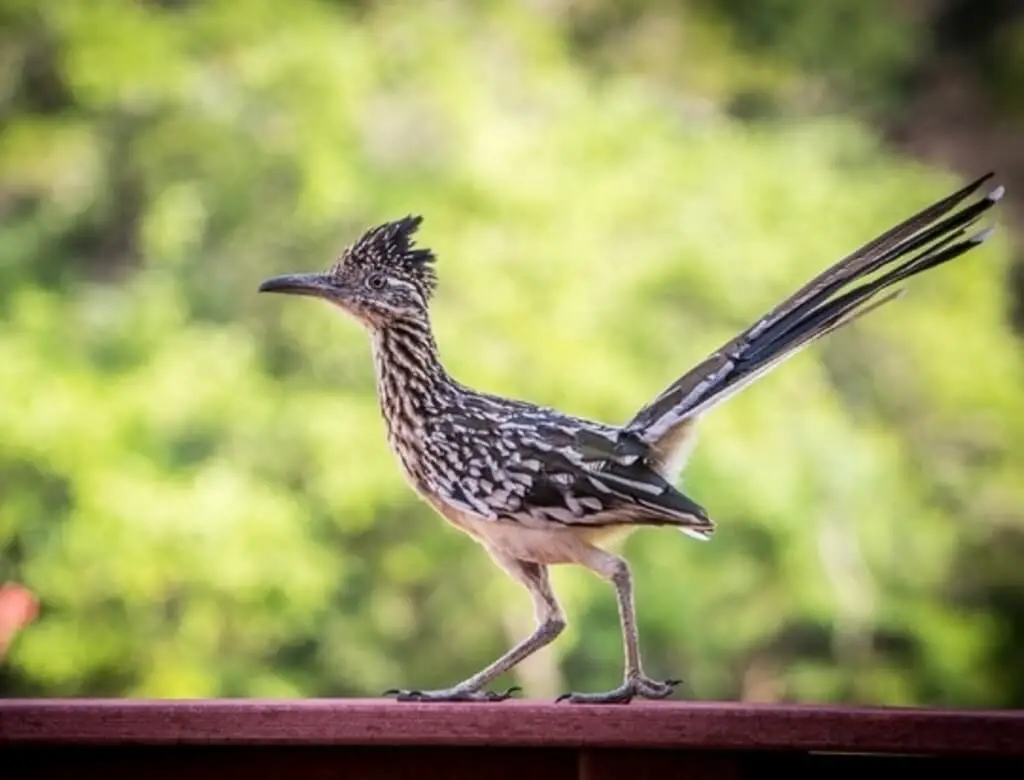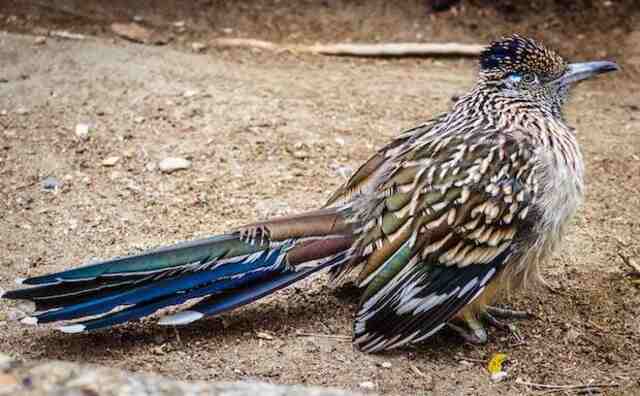Have you ever watched a roadrunner dash across the desert at lightning speed and wondered just how much you really know about this fascinating bird? These quick, quirky creatures are more than just the stuff of cartoons.
From their surprising habits to their incredible physical abilities, there’s a lot more to these birds than you might think. Get ready for some fun facts about roadrunners that will leave you amazed by their unique traits and skills!
Table of Contents
- 1 Understanding The Types of Roadrunners
- 2 Fun Facts About Roadrunners
- 2.1 The Roadrunner Can Reach Speeds Up to 25 Miles Per Hour.
- 2.2 The Desert’s Camouflage Artists
- 2.3 The Roadrunner Is a Type of Ground Cuckoo.
- 2.4 There Are Only Two Species of Roadrunner.
- 2.5 The Roadrunner has a Long Lifespan.
- 2.6 Roadrunners have a Complex Diet.
- 2.7 Roadrunners Are Found in Deserts…
- 2.8 Roadrunners Nest on the Ground.
- 2.9 Roadrunners Are Monogamous and Mate for Life.
- 2.10 Roadrunners have Zygodactyl Feet.
- 2.11 Roadrunners have Elaborate Courtship Displays
- 2.12 Roadrunners Can Only Fly Short Distances.
- 2.13 They Lower Their Body Temperature to Survive Cold Nights
- 2.14 The Roadrunner’s Unique Egg-Cracking Technique
- 2.15 They Have A Cooperative Nest Building Behavior
- 2.16 Heat-Tolerant Survival in the Desert
- 2.17 They Have Opportunistic Predatory Habits
- 2.18 They Have A Solitary Roosting Behavior
- 2.19 Roadrunners’ Have Fascinating Vocalizations
- 3 Frequently Asked Questions
- 4 Author
Understanding The Types of Roadrunners
Greater Roadrunner
The Greater Roadrunner is an easy bird to identify, with its light brown and white patterning throughout the upper body and breast, with a plain white belly. It has a large crest that is streaked brown and white. The wings are also patterned brown with white, and it has a very long tail. They also have a long dark gray beak that has a hooked tip.
- Length: 20.5-21.3 in (52-54 cm)
- Weight: 7.8-19.0 oz (221-538 g)
- Wingspan: 19.3 in (49 cm)
- Range: Central and southern Texas, Arizona, New Mexico, up to Oklahoma.
- Habitat: Deserts, scrublands, chaparral areas, grasslands and farmlands.
- Diet: Crickets, spiders, mice, rabbits, snakes, lizards, berries, prickly pear cactus fruit.
- Lifespan: 8 years
- Population: 1.1 Million (Least Concern)
- Speed: 26 mph (42 km)
- Scientific Name: Geococcyx californianus
- Family: Cuculidae
- Genus: Geococcyx
Lesser Roadrunner
The Lesser Roadrunner has a dark brown almost black and white patterning throughout the upper body and breast, with a plain white belly. It has a large crest that is streaked brown and white. It has a small white patch around the eye The wings are also patterned brown with white, and it has a very long tail. They also have a long dark gray beak that has a hooked tip.
- Length: 18.1-20.1 in (46-51 cm)
- Weight: 6.1-7.3 oz (174–207 grams)
- Wingspan: 18.0 in (45.7 cm)
- Range: Southwestern United States, Mexico, northern Baja California, Sonora, Chihuahua, Coahuila, Durango, Zacatecas, San Luis Potosí.
- Habitat: Plains, desert scrubland, agricultural land or grasslands.
- Diet: Snakes, lizards, eggs, rodents, fruit, berries, plant material.
- Lifespan: 8 years
- Population: 500,000-4,999,999 (Least Concern)
- Speed: 20 mph (32 km)
- Scientific Name: Geococcyx velox
- Family: Cuculidae
- Genus: Geococcyx
Fun Facts About Roadrunners
The Roadrunner Can Reach Speeds Up to 25 Miles Per Hour.
Roadrunners are renowned for their incredible running abilities. They can achieve speeds of up to 26 mph (42 kph) and maintain a steady pace of 15 to 20 miles per hour (24 to 32 kilometers per hour) for extended periods. This exceptional speed makes them proficient desert predators, chasing down prey and evading threats.
The Desert’s Camouflage Artists
In addition to their running prowess, roadrunners are adept at blending into their arid environments. Their brown and white mottled plumage provides effective camouflage, making them less conspicuous to both prey and potential predators. This natural disguise aids in their survival.
The Roadrunner Is a Type of Ground Cuckoo.
The Roadrunner is a type of ground cuckoo that can be found throughout most of the Southwestern United States, Mexico, Central America, Western Texas and into Northern parts of Guatemala. This bird is mainly recognized by its characteristic calls, which sound like “Beep-beep” or “Whoop-whoop.”
There Are Only Two Species of Roadrunner.
There are only two species of roadrunner, the Greater and Lesser. The Greater is found in the southwestern United States and Mexico, while the Lesser is only found in northern Mexico.
The Roadrunner has a Long Lifespan.
The average lifespan of a roadrunner is about 8 years in the wild, but up to 16 years in captivity. The major factor that affects the longevity of this bird species is habitat loss and fragmentation. As human development continues to expand into wildlife habitats, many populations are dwindling or becoming extinct altogether.
Roadrunners have a Complex Diet.
Roadrunners are North American birds that have a diet consisting of insects, rodents, snakes, lizards and birds’ eggs as well as plants such as agave flowers or yucca fruits. The most common prey items are grasshoppers (over 90% of the diet), followed by beetles, scorpions and other insects. They can also be seen eating berries from bushes such as mulberry trees.
Roadrunners Are Found in Deserts…
The Roadrunners preferred habitats include deserts, grasslands, chaparral scrubland, and forests from sea level to around 6000 feet. They are usually found in places with a mix of open areas and brushy cover for nesting and hiding.
Roadrunners Nest on the Ground.
Roadrunners usually build their nests on low trees, shrubs, or cacti, 3 to 10 feet above the ground and lay two to six eggs per clutch. Roadrunners typically nest during the late spring and early summer months, but may also nest at other times of year.
Roadrunners Are Monogamous and Mate for Life.
The male attracts the female by performing a ritualized display of head bobbing, and vocalizing its distinctive call. The female approaches the male and the two birds touch beaks in a courtship dance before mating.
In order to form pairs, males often search around a nesting area for several days before they find females that are ready to mate. Once paired up with their partner, they may stay together until one of them dies or the other leaves the area.
Roadrunners have Zygodactyl Feet.
Roadrunners have Zygodactyl feet, which means they have two toes pointing forwards, and two toes pointing backwards. This is an adaptation to running quickly over rough terrain.
Roadrunners have Elaborate Courtship Displays
The roadrunner is a large bird that has an elaborate courtship display. Males will puff up their feathers and then put on a dance show, while females will often watch from the ground nearby. Male roadrunners also have what’s called a “wing flutter,” where they spread their wings out and rapidly flap them together in order to make sounds with their wing feathers.
They will strut around with their wings outstretched while making high-pitched chirping sounds, showing off his colorful plumage to impress potential mates as he tries to court them with his elaborate display that can go on for several hours.
Roadrunners Can Only Fly Short Distances.
Roadrunners are one of North America’s most well-adapted terrestrial birds. Unlike many other birds, they rely primarily on running and can only fly short distances, making them better suited for life on the ground. They are also non-migratory, staying in the same area year-round if food remains available.
They Lower Their Body Temperature to Survive Cold Nights
Roadrunners are primarily diurnal animals, meaning they’re active during the day. Roadrunners often use sunspots on roads to keep warm when it’s cold outside, but how do they survive cold nights?
A recent study found that roadrunners reduce their body temperature by 10 degrees Fahrenheit (5.6 degrees Celsius) during nighttime hours in order to survive the nighttime desert temperatures.
They accomplish this by reducing heat production and increasing blood flow near their skin surface so that they can lose heat by radiation, convection and conduction.
The Roadrunner’s Unique Egg-Cracking Technique
When it comes to opening eggs, roadrunners have an unusual method. Rather than using their beaks, they grasp an egg in their mouths and position it against a hard surface, such as a rock. They then deliver a swift blow to crack the egg open, enabling them to access the nutritious contents inside.
They Have A Cooperative Nest Building Behavior
Roadrunners are cooperative when it comes to building their nests. Mated pairs work together to construct a cup-shaped nest made of sticks, leaves, and other materials. This collaborative effort ensures a secure and stable home for their offspring.
Heat-Tolerant Survival in the Desert
Roadrunners are well-adapted to the scorching desert heat. They have specialized nasal glands that excrete excess salt, helping them conserve water. Additionally, roadrunners often use shade and sunspots on roads to regulate their body temperature and stay cool.
They Have Opportunistic Predatory Habits
Roadrunners are opportunistic hunters. They employ various hunting techniques, including stalking, pouncing, and even cooperative hunting with their mate. Their primary targets include insects, reptiles, and small rodents.
They Have A Solitary Roosting Behavior
While roadrunners may mate for life, they often roost separately at night. They seek out perches like cacti or shrubs, which provide safety from ground predators. These solitary roosting habits help reduce competition for prey among mated pairs.
Roadrunners’ Have Fascinating Vocalizations
Roadrunners communicate using a range of distinctive vocalizations, including a signature “cooing” sound. These calls serve various purposes, such as defending territory, attracting mates, and signaling the presence of predators.
Frequently Asked Questions
Are Roadrunners smart?
Roadrunners are indeed very smart. They have a well-developed spatial memory, meaning they can remember where they had stored food, what type of food it was, and when they last ate from it.
Can Roadrunners be pets?
Roadrunners are not pets. They cannot be domesticated, so they should never be treated as such.
What color are Roadrunner eggs?
One other interesting fact about roadrunners is that they lay white eggs, which are incubated by the sun’s heat as well as under a parent bird. These eggs require both the sun’s heat and parental incubation to hatch successfully.
Do Coyotes eat Roadrunners?
Coyotes are known to eat a variety of prey including rodents, small mammals, deer, and birds. They have been seen hunting in packs or alone, but most commonly hunt at night. One type of prey coyotes often hunt is the roadrunner. Coyotes also seem to be very opportunistic animals and will take any chance they can get to catch their next meal.
Are Roadrunners dangerous?
Roadrunners do not pose a significant threat to humans unless they are cornered or threatened. If you see one, it is best to avoid it, and not cross paths. They have powerful claws that could harm someone when they have to defend themselves.




